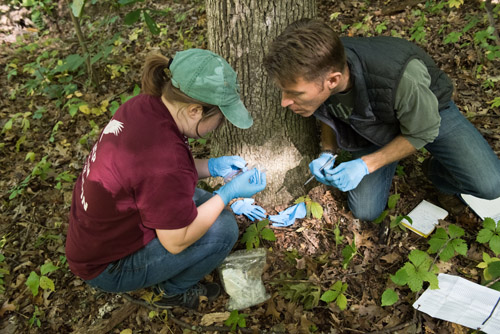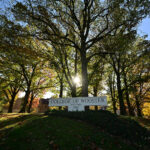
Local Discovery of New Salamander Breed Leads to Scientific Publication

WOOSTER, Ohio – Peak under a rock at Wooster Memorial Park or Secrest Arboretum, and you may come face-to-face with an unusual breed of salamander. It was first discovered locally and then found in a few other areas of northeast Ohio, confirmed via research by The College of Wooster’s Richard Lehtinen, associate professor of biology and chair of the environmental studies program.
Lehtinen’s recently published work, “Identification of Widespread Hybridization Between Two Terrestrial Salamanders Using Morphology, Coloration, and Molecular Markers,” in the scientific journal Copeia, details the first known breeding between red-back salamanders and ravine salamanders, a surprising development according to the long-time amphibian expert.
The exploration of this topic began in 2003 when Lehtinen first came to Wooster and was unable to identify some salamanders during regular trips to Wooster Memorial Park, and as the years went by there were still 10-20% he could not classify. “These things are just weird. They don’t fall into one category or another, maybe they’re hybridizing with one another,” he recalled thinking.
So, Lehtinen and a team of students put the theory to test. “Over a series of years, we developed DNA markers that would help us distinguish pure red-bank salamanders and pure ravine salamanders from hybrids. Those DNA markers told us not only are those two species mating with each other, but they’re doing it very, very frequently. That was surprising to us,” he explained.
“This is the first paper that demonstrates clearly these two species can and do hybridize, and there is hybridization going on extensively here in our backyard at Wooster Memorial Park and Secrest Arboretum as well as in other parts of northeast Ohio,” he added.
This fall and beyond, Lehtinen plans to continue this research, extending the project to southern Ohio, with the goal of studying the evolutionary state of these two species of salamanders. “I’m interested in this from an evolutionary standpoint. I think it can tell us something interesting as to how new life forms come about. Most people focus on how species initially diverge from one another. We’re looking at it from the back end, reverse speciation.”
Fellow researchers and co-authors of the published article were Wooster alums Emlyne Cassagnol ‘09, Hilary Edgington ‘10, Meredith Eyre ‘13, Anthony Steratore ‘12, and Mitchell Stern ‘14.
Image: Wooster senior Julia Fregonara and professor of biology Rick Lehtinen examine a salamander at Wooster Memorial Park.
Posted in News on October 3, 2016.
Related Posts
Related Areas of Study
Earth Sciences
Geology, environmental geoscience, geophysics, and other classes that explore Earth and the impact of humans
Major MinorGeology
Start research in your first year and graduate with a strong foundation in the Earth Sciences.
Major Minor

